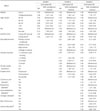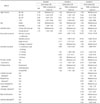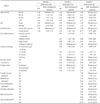1. Hetta J, Broman JE, Mallon L. Evaluation of severe insomnia in the general population--implications for the management of insomnia: insomnia, quality of life and healthcare consumption in Sweden. J Psychopharmacol. 1999; 13:4 Suppl 1. S35–S36.
2. Kim K, Uchiyama M, Okawa M, Liu X, Ogihara R. An epidemiological study of insomnia among the Japanese general population. Sleep. 2000; 23:41–47.

3. Kuppermann M, Lubeck DP, Mazonson PD, Patrick DL, Stewart AL, Buesching DP, et al. Sleep problems and their correlates in a working population. J Gen Intern Med. 1995; 10:25–32.

4. Leger D, Poursain B. An international survey of insomnia: under-recognition and under-treatment of a polysymptomatic condition. Curr Med Res Opin. 2005; 21:1785–1792.

5. Okuji Y, Matsuura M, Kawasaki N, Kometani S, Shimoyama T, Sato M, et al. Prevalence of insomnia in various psychiatric diagnostic categories. Psychiatry Clin Neurosci. 2002; 56:239–240.

6. Krakow B, Melendrez D, Ferreira E, Clark J, Warner TD, Sisley B, et al. Prevalence of insomnia symptoms in patients with sleep-disordered breathing. Chest. 2001; 120:1923–1929.

7. Ohayon MM, Lemoine P. [A connection between insomnia and psychiatric disorders in the French general population]. Encephale. 2002; 28(5 Pt 1):420–428.
8. Ohayon MM. Prevalence of DSM-IV diagnostic criteria of insomnia: distinguishing insomnia related to mental disorders from sleep disorders. J Psychiatr Res. 1997; 31:333–346.

9. Roth T, Jaeger S, Jin R, Kalsekar A, Stang PE, Kessler RC. Sleep problems, comorbid mental disorders, and role functioning in the national comorbidity survey replication. Biol Psychiatry. 2006; 60:1364–1371.

10. Ohayon M. Epidemiological study on insomnia in the general population. Sleep. 1996; 19:3 Suppl. S7–S15.

11. Cho YW, Shin WC, Yun CH, Hong SB, Kim J, Earley CJ. Epidemiology of insomnia in Korean adults: prevalence and associated factors. J Clin Neurol. 2009; 5:20–23.

12. Shapiro CM, Devins GM, Hussain MR. ABC of sleep disorders. Sleep problems in patients with medical illness. BMJ. 1993; 306:1532–1535.

13. Moldofsky H. Sleep and pain. Sleep Med Rev. 2001; 5:385–396.

14. Klink M, Quan SF. Prevalence of reported sleep disturbances in a general adult population and their relationship to obstructive airways diseases. Chest. 1987; 91:540–546.

15. American Psychiatric Association. Diagnostic and statistical manual of mental disorders: DSM-IV. 4th ed. Washington, DC: American Psychiatric Association;1994.
16. Ford DE, Kamerow DB. Epidemiologic study of sleep disturbances and psychiatric disorders. An opportunity for prevention. JAMA. 1989; 262:1479–1484.

17. Salo P, Sivertsen B, Oksanen T, Sjösten N, Pentti J, Virtanen M, et al. Insomnia symptoms as a predictor of incident treatment for depression: prospective cohort study of 40,791 men and women. Sleep Med. 2012; 13:278–284.

18. Xiang YT, Ma X, Cai ZJ, Li SR, Xiang YQ, Guo HL, et al. The prevalence of insomnia, its sociodemographic and clinical correlates, and treatment in rural and urban regions of Beijing, China: a general population-based survey. Sleep. 2008; 31:1655–1662.

19. Cho SJ, Oh DH, Lee JA, Choi BY, Park YC, Nam JH. Prevalence of main psychiatric disorders in relation to urbanization in Gyeonggi Province by using the Korean version of the mini-international neuropsychiatric interview. J Korean Neuropsychiatr Assoc. 2011; 50:288–296.
20. Lim SW, Song HS, Oh YH, Shin HC, Cho KH, Chung SK. A validation study of the abbreviated self-rated Korean version of MINI (MINI patient health survey). Anxiety Mood. 2007; 3:32–40.
21. Bastien CH, Vallières A, Morin CM. Validation of the insomnia severity index as an outcome measure for insomnia research. Sleep Med. 2001; 2:297–307.

22. Cho YW, Song ML, Morin CM. Validation of a Korean version of the insomnia severity index. J Clin Neurol. 2014; 10:210–215.

23. Ohayon MM, Hong SC. Prevalence of insomnia and associated factors in South Korea. J Psychosom Res. 2002; 53:593–600.

24. Ohayon MM, Partinen M. Insomnia and global sleep dissatisfaction in Finland. J Sleep Res. 2002; 11:339–346.

25. Ohayon MM. Epidemiology of insomnia: what we know and what we still need to learn. Sleep Med Rev. 2002; 6:97–111.

26. Vallières A, Ivers H, Bastien CH, Beaulieu-Bonneau S, Morin CM. Variability and predictability in sleep patterns of chronic insomniacs. J Sleep Res. 2005; 14:447–453.

27. Zhang B, Wing YK. Sex differences in insomnia: a meta-analysis. Sleep. 2006; 29:85–93.

28. Roepke SK, Ancoli-Israel S. Sleep disorders in the elderly. Indian J Med Res. 2010; 131:302–310.
29. Ancoli-Israel S, Roth T. Characteristics of insomnia in the United States: results of the 1991 National Sleep Foundation Survey. I. Sleep. 1999; 22:Suppl 2. S347–S353.
30. Breslau N, Roth T, Rosenthal L, Andreski P. Sleep disturbance and psychiatric disorders: a longitudinal epidemiological study of young adults. Biol Psychiatry. 1996; 39:411–418.

31. Henderson S, Jorm AF, Scott LR, Mackinnon AJ, Christensen H, Korten AE. Insomnia in the elderly: its prevalence and correlates in the general population. Med J Aust. 1995; 162:22–24.

32. Chang PP, Ford DE, Mead LA, Cooper-Patrick L, Klag MJ. Insomnia in young men and subsequent depression. The Johns Hopkins Precursors Study. Am J Epidemiol. 1997; 146:105–114.








 PDF
PDF ePub
ePub Citation
Citation Print
Print




 XML Download
XML Download